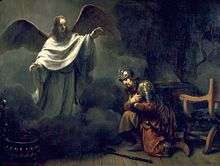Cornelius the Centurion
| Cornelius the Centurion | |
|---|---|
|
Peter Baptizing the Centurion Cornelius, by Francesco Trevisani, 1709. | |
| Born | unknown |
| Died | unknown |
| Venerated in |
Roman Catholicism Eastern Orthodox Church Anglican Communion |
| Feast | 2 February,[1] 7 February, 13 September |
| Attributes | Roman military garb |
Cornelius (Greek: Κορνήλιος) was a Roman centurion who is considered by Christians to be the first Gentile to convert to the faith, as related in Acts of the Apostles and, perhaps the Gospel according to John.
Biblical account
Cornelius was a centurion in the Cohors II Italica Civium Romanorum, mentioned as Cohors Italica in the Vulgate.[2] He was stationed in Caesarea, the capital of Roman Iudaea province.[3] He is depicted in the New Testament as a God-fearing man who always prayed and was full of good works and deeds of alms. Cornelius receives a vision in which an angel of God tells him that his prayers have been heard, he understands that he's chosen for a higher alternative. The angel then instructs Cornelius to send the men of his household to Joppa, where they will find Simon Peter, who is residing with a tanner by the name of Simon.
The conversion of Cornelius comes after a separate vision given to Simon Peter (acts 10:10–16) himself. In the vision, Simon Peter sees all manner of beasts and fowl being lowered from Heaven in a sheet. A voice commands Simon Peter to eat. When he objects to eating those animals that are unclean according to Mosaic Law, the voice tells him not to call unclean that which God has cleansed.[4]
When Cornelius' men arrive, Simon Peter understands that through this vision the Lord commanded the Apostle to preach the Word of God to the Gentiles. Peter accompanies Cornelius' men back to Caesarea.[4] When Cornelius meets Simon Peter, he falls at Peter's feet. Simon Peter raises the centurion and the two men share their visions. Simon Peter tells of Jesus' ministry and the Resurrection; the Holy Spirit descends on everyone at the gathering. The Jews among the group (presumably they were all Jews if Cornelius was the first gentile convert, see Jewish Christians) are amazed that Cornelius and other uncircumcised should begin speaking in tongues, praising God. Thereupon Simon Peter commands that Cornelius and his followers be baptized.[5] The controversial aspect of Gentile conversion is taken up later at the Council of Jerusalem (acts 15), but has its roots in the concept of "proselytes" in the Septuagint (the Greek translation of the Hebrew Bible) and Jewish Noahide Law.
Peter later chose not to eat with Gentiles in Antioch after some Jews criticized him. The apostle Paul publicly confronted Peter for being hypocritical as related in Galatians 2.
Significance

Cornelius was the first Gentile converted to Christianity.[7] Florentine Bechtel summarizes the importance of Cornelius' baptism:
The baptism of Cornelius is an important event in the history of the Early Church. The gates of the Church, within which thus far only those who were circumcised and observed the Law of Moses had been admitted, were now thrown open to the uncircumcised Gentiles without the obligation of submitting to the Jewish ceremonial laws.[3]
Certain traditions hold Cornelius as becoming either the first bishop of Caesarea or the bishop of Scepsis in Mysia.[3][5]
Commemoration
His feast day on the General Roman Calendar is 2 February. He is commemorated in the Orthodox tradition on 13 September.[4]
Cornelius is honored with a commemoration in the liturgical calendar of the Episcopal Church in the United States of America on February 7.[8] When Governor's Island, New York, was a military installation the Episcopal Church maintained a stone chapel there dedicated to him.
The Greek-French philosopher Cornelius Castoriadis is named after him.[9]
Gallery
- Images of St. Cornelius Chapel, Governor's Island, New York
-
Chapel exterior
-

Three military saints in the reredos (Cornelius on the right)
-

Stained glass window based on Acts 10
See also
Notes and references
- ↑ Jones, Terry. "Cornelius the Centurion". Patron Saints Index. Retrieved 2007-03-18.
- ↑ Bromiley, Geoffrey W., International Standard Bible Encyclopedia, Wm. B. Eerdmans Publishing, 1979, p. 297
- 1 2 3 Bechtel, Florentine. "Cornelius." The Catholic Encyclopedia. Vol. 4. New York: Robert Appleton Company, 1908. 24 Apr. 2013
- 1 2 3 "Hieromartyr Cornelius the Centurion", Orthodox Church in America
- 1 2 "The Departure of St. Cornelius the Centurion", Coptic Orthodox Church Network
- ↑ "Vision of Cornelius the Centurion". The Walters Art Museum.
- ↑ Kiefer, James E., "Cornelius the Centurion", Biographical sketches of memorable Christians of the past, Society of Archbishop Justus
- ↑ "Cornelius the Centurion", the Episcopal Church
- ↑ François Dosse. Castoriadis. Une vie. Paris: La Découverte, 2014, p. 13.
External links
- Saint Cornelius the Centurion at the Christian Iconography web site
- The Story of the Chapel of St. Cornelius the Centurion at Governor's Island, New York Harbor, Written for the Day of the Consecration, October 19, A.D. 1906. by Morgan Dix
| Preceded by Position created |
Bishop of Caesarea before 189 |
Succeeded by Theophilus |
